#anyhow that’s all from me
Text
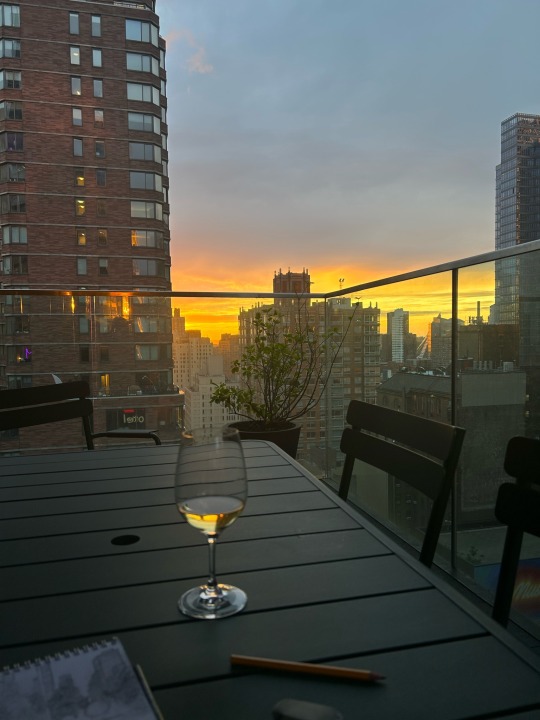
New York has been treating me pretty well ✨
#although the slight shift in culture keeps hitting me in the face#also it’s super difficult to make small talk here like I’m feeling like the most awkward person ever which usually isn’t a thing#but a lot of learning!#and I’ve been pushing myself to make sketches!#so. many. windows.#anyhow that’s all from me#questwithambition#studyblr#new york#new york city#view#sunset#wine#aesthetic#travel
39 notes
·
View notes
Text
A question I have just recently,
can Sebek handle spicy?

this is what i generally think of fae.
tho i think,
lilia knows spicy spices from his travel.
even tho in dragon form, malleus breathes fire from his mouth, and fire is hot, it might be like the kind of fire that doesn't hurt him in the first place
sebek father might bring spicy spice from human world with him, but since i think of him as a mellow man, he might not be interested in spicy food in the first place
#honestly it makes me wonder all the nrc students ability to handle spiciness & i wish everyone would start putting them into tiers#twst#twisted wonderland#do i tag this as sebek#i do want to know what others think of him#sebek zigvolt#i think the octas would be very bad at it#but floyd probably keeps on challenging it so he gains tolerance over it#riddle would be very bad with it#ace would be pretty good#but deuce would be a little less#or do u think punk him would dare other punks on spicy food#who would shed tears#who would break a sweat#who would eat like it's nothing#who would wail asking the great seven to take them to the after world#i am just wondering bcs of the rabbit sausage roll in deuce hometown#leona who never lift a finger finally break a sweat from spicy food#who knows we even see tears in his eyes while he endures it silently#can vil stay beautiful eating spicy food#despite his tough claim can epel handle spicy#anyhow do u know there's samyang 1/2 spicy now#that's the only one i can eat without suffering like actually enjoying it#idia i feel like he would wrinkle from spicy food#but what if he is some connoisseur of instant noodles so he had been eating spicy ones quite a lot#my brother always love to see me suffer over spiciness
655 notes
·
View notes
Text

Wei Wuxian eats a watermelon. Yep!
#poorly drawn mdzs#mdzs#wei wuxian#nothing out of the ordinary here. Just good fandom fun#Watermelon discourse has been going on and I want to let people know where I stand.#This came about because I wanted to experiment with translating the (traditional) PD-MDZS style to a digital format#and while sitting there thinking of what to draw...my inspiration came to me.#This is the equivalent of sneaking vegetables into the spaghetti sauce but its important to get your gotdamn veggies#I'm not very good at organizing my thoughts (evidence: the tags of every post on this blog).#but please do not look away from this moment in history. One person cannot solve it and no one expects you to.#Even if it is just spending time doing some research on the situation and history. Or boosting posts that are more articulate#Any action helps! ANY action! Everyone has a different level of capacity for this and that's okay. Anything is fine. Dont let it be nothing#Anyhow. did I like doing this digitally? Yes but its mixed. It was faster but also spark the same joy I usually get while drawing#I will have to get over it very quickly though. You will all see why in a few days
905 notes
·
View notes
Photo






Just keep getting back up (Patreon)
#Doodles#Handplates#UT#Fellplates#Gaster#Asgore#The thought of Gaster able to heal himself! Rather to only have himself to rely on in a world that lives to hurt him (and everyone else)#It's an interesting inversion that's for sure#Is it as satisfying if it's not the one who deserves the broken bones? The pain of rejection or of justice retribution punishment?#It's still the same face - and it's not like he's wholly innocent here either#And besides it's always fun to draw tears hee ♪#Get him just a bit disheveled aside from the broken bone - it's hard to imagine him in different clothes even after drawing him in the dress#Softer clothes would be so nice to hold Babybones with but even just dropping a shoulder off his coat or untying his bow tie - it's strange!#I do like the image of his flower crown shedding petals when he gets roughed up tho hehe - tossed around just a little too much!#Breaking his hand right down the middle - it'd be much easier with the holes in his hands as a weak point#All his bones could break easier than his hands before that but now-#It's weird to draw Asgore like that lol I dunno....Works well enough for utility but pffblt :P I always forget his pauldrons anyhow lol#Really rubbing it in that Gaster will be fiiiine he's sooooo special what with his ability to heal >:( Lol#It does make him a bit of a target - a regenerating punching bag? Ideal to see just how far you can push him#It was fun to draw with my green coloured pencil as well ahh <3 Healing magic always gives me a bit of the warm fuzzies#It was the original comic that made me fall in love with Handplates after all ♥ Pretty and feelings <3
187 notes
·
View notes
Photo

“the sleeping princess finally woken up”
#pokemon reborn#pkmn reborn#KArts#the ''orphanage'' gang and the rival#tbh. i feel like Shelly and Charlotte are the only one who would have had stronger reaction to Cain's returns#Shelly cuz' she sorta been with him from the start. Charlotte. their ''princess'' conversation is cute for me.#and i thought Charlotte do enjoy Cain's company.#Heather and Noel is...i guess appreciation?#idk#come to think about it. Victoria and Cain never battle with each other#actually. Fern/Vic/Cain are all your rivals and they doesn't get to be in the same room XD#wait. i think only Cain and Fern not fully interacted with each other#anyhow. after ranting in the tags. i realized i didn't draw Aya here...
429 notes
·
View notes
Text
hi! ok so i'm going to talk about one of my top-five favourite things, which is: dyeing stuff! this is going to be specifically about dyeing protein fibres (animal fibres—wool, alpaca, silk, etc) in a pretty low-key way in your kitchen.
to be clear up front: this is not the most scientific, most perfectly reproducible, or most Objectively Correct way to dye things. i get a lot of fibre that i like this way, though, and i think that other people can, too.
fibre i've dyed that i think is neat:
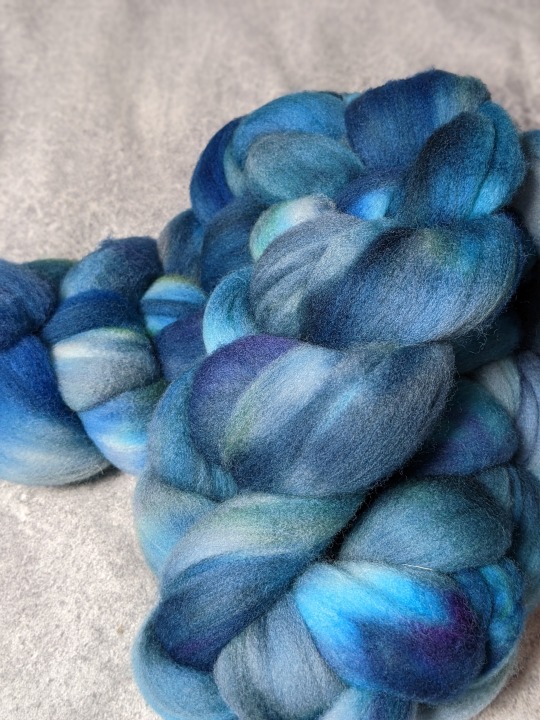
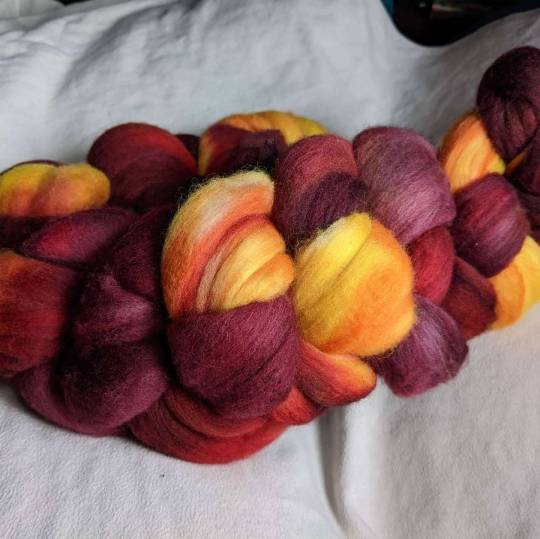

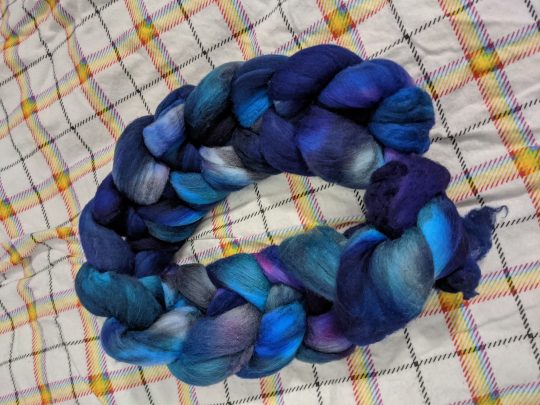
you can also dye yarn like this:

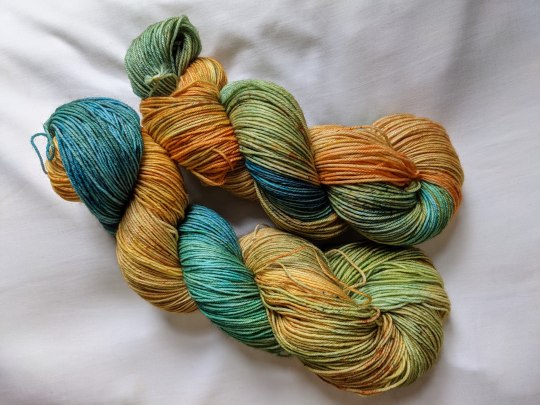
yes, i like blue a lot. i also really like variegation and heathering, which is why most of the fibre here has patches of white—it's an intentional choice that i've made. you can make different choices.
here is what you need to dye things:
fibre, vinegar, dye, a pot, heat, and some water.
that was so you don't get overwhelmed by the impending wall of text. here is what you need to dye things (it's the same stuff!), but with way more detail:
fibre or yarn. this is the big one, obviously. i tend to dye in 100-200 gram batches, because that's approximately what fits on my stovetop easily. if you're very nervous about felting or harming your fibre, you can use stuff that's been treated to be superwash, start with yarn (which is harder to felt than fibre is), or use a felt-resistant breed like dorset or suffolk. honestly, though, i learned with merino because that's what i had, and it was fine. again, though, this guide is only for protein fibres. it will not work for things like cotton. the only exception to this is nylon, which will take on some colour, but less than a protein fibre will.
a mordant. this is a fancy way of saying a thing that makes dye stick, and for what we're doing here, it's citric acid or vinegar. your grocery store definitely has at least one of them, though if you can choose, i prefer citric acid, because i love wet wool smell but i do not always love wet wool vinegar smell.
dye. i use acid dyes, and am personally deeply loyal to dharma acid dyes, but ashford and jacquard acid dyes work the same way. if you don't want to buy dye or don't have access to it, food colouring will often work, as well, though i haven't tried this with natural food colourings and have no idea how well they'll work.
a dedicated dye pot. ok, if you're doing food dyes, you don't need this. if you're not, it's definitely best practice, though i don't know how dangerous it is not to. any large metal pot will do, but my favourite option is hotel pans, which are those huge metal pan/tray things that hold food at buffets and the like. i have a full-size one that's 15cm deep, and a half-size one that's 4cm deep. they're great because they let you lay out the fibre you're working with so you can see most of it in a single layer.
dedicated dye utensils. as before, i don't know how much of a huge deal this is. i'll be honest and admit that for several years i had a single pair of tongs that got used for all tong-requiring events, including dyeing, and i'm still alive. i suggest that you have at least a big spoon, and a big spoon and tongs are even better.
something to mix the dye in. yeah, i use empty plastic sports drink or soda bottles for this. you can be fancy and get mason jars or little squirt bottles or whatever, and if you get super into dyeing you'll want to mix up dye stocks, but that's way outside the scope of what we're doing here. i like the powerade bottles that have a little squirty mouthpiece, because it's fun to squirt dye onto things.
personal protective equipment. i think this is the part of things that freaks people out. ideally, you wear plastic gloves and a mask (yeah, like your covid masks) when you're working with dye. realistically, i almost never remember to put on gloves and just accept that my hands are going to be blue sometimes. you should wear a mask, because dye is an irritant, but the world is an imperfect place and i have wicked bad adhd and sometimes i forget. this isn't advice. i'm just being honest. you should use some kind of safety stuff. you probably won't die if you don't.
you might also want some little random bits: an old toothbrush or paintbrush, a pipe cleaner, some toothpicks, etc. this is mostly if you like speckles, or if you want very small patches of colour.
so first: there are a million ways to dye things, and i'm not convinced that any of them are objectively correct. i do what i do and it works for me. some of the things i do are the opposite of what most guides suggest, but i do them because i like the effects they create.
ok, that's all the background stuff you need. let's dye some stuff!
the number one most important thing to remember when you're dyeing is this:
you can always add more colour. you cannot take it away.
that's in fancy writing and bold because every once in a while i forget this, and every single time i end up regretting it.
here is how to dye things:
put water, citric acid (or vinegar), and fibre into a pot. add dye and heat. let cool completely. rinse the fibre in cool water, then hang to dry.
like, sure, we're going to go into way more detail, but push come to shove, if you do that, you're going to end up with dyed fibre. there are a lot of tutorials telling you that you must soak your fibre first, or you must add your citric acid this way, or hold the water at exactly this temperature, and i'm here to tell you that while any of these things can give you different results, those results aren't necessarily better.
the only way that you can totally screw this up is by accidentally felting your fibre, so before i get into the way more detail part of things, i'm going to talk about that.
how not to felt your fibre
i feel like if you've read this far, you know how things felt: wool, heat, and agitation. you may also notice that at least two of these things are required for dyeing. this can be stressful! but you don't have to be afraid of it. there's only been one time that i felted something to the point that it was unusable, and that happened because i literally fell asleep for several hours while the pot was on the stove. you can avoid doing this by simply setting an alarm—this is a good idea anyhow, because you'll want to check on your dye pot!
when you're dyeing, use the lowest heat that you can while still keeping the water at a simmer. if your stove, like mine, has one burner that's wildly unpredictable and sort of out of control, you may want to look for some sort of flame diffuser, also called a flame tamer or a simmer ring. i bought one on amazon for about fourteen dollars, and it's literally just a thick metal circle. it works fine.
you can also keep the heat low by using a pot with a thick bottom, though in my experience those are expensive, and if i had one i would be using it for soup, not wool.
avoid shocking your wool—never put room temperature wool into hot water, and never put hot wool into cold water. leave your wool in the dye bath until it's cooled completely, which for me usually means overnight.
finally, obviously you have to move the fibre around some. you'll need to peek under it in the pan, and when you're done, you have to rinse it and squish out the water. try to minimise handling, though. don't run water directly onto the fibre, don't get a wooden spoon and stir your dye pot around, don't wring the fibre dry when it's done.
you're probably never going to be perfect. i often find that i lose a gram or two of wool where fibres have grabbed onto each other, or where parts of the ends clumped up. it's not really felted, just sort of compacted, but it's not great to work with, and i'd rather lose a gram of fibre than fuss with the clumpy bits.
back to how to dye things
let's take it step by step, assuming a hundred grams of fibre.
put your pan on the stove and fill it halfway with water. add either a teaspoon of citric acid or a tablespoon of vinegar. this is going to help the dye strike, or stick to the fibre. the teaspoon/tablespoon is a guideline, but one that it's fine to exceed. adding more will help the dye strike faster, which can be useful if you're trying to create blocks of colour on your fibre. i usually err on the side of a little more than the guidelines, and just eyeball this—if you feel like the dye isn't taking well, you can add more later.
add your fibre to the pan. this is the first place you have to think about what you want the finished fibre to look like! you can put it into the pan any way you want, but i suggest trying to keep it in a relatively even layer, regardless of what that layer looks like. here are some ways to get specific effects:
if you want a gradient from one end of the fibre to the other, use a rectangular pan and lay your fibre out so that the line of it is parallel to the short sides of the pan
if you want a short, repeating gradient, use a rectangular pan and lay your fibre out so that the line of it is parallel to the long sides of the pan
if you want something that starts with very close repeats that get further apart as you go down the fibre, make an approximate spiral
if you don't want A Pattern (i usually don't) just lay things out in a single layer, more or less
here comes the next exciting part! decide if you want to let your fibre soak or not. again, doing or not doing this gives you some different effects!
soaking your fibre will mean that dye takes more evenly. if you want consistent colours, you'll want to soak.
not soaking your fibre means that the dye takes less evenly. the fibre on top will have less acid available to it, spends less time in the dye bath, and also has to actually get wet before it will start to dye. i actually love doing this, and think it affords a lot of cool opportunities to play with and layer colours.
if you're soaking, leave the fibre there until it's submerged. if not, don't.
now you're going to add dye! decision time, again.
you can add dye when the water is cold, which will give you more even dye coverage, and in my experience gives the colours more time to mix together
you can add dye when when the water is hot, which will give you less even coverage, and tends to encourage the colours to stay more delineated
probably surprising no one, i tend to heat the water first unless i'm starting with a base colour or i'm doing a two-colour gradient.
time to mix up some dye
as i mentioned earlier, i'm assuming that you're using powered acid dyes for this. if you're not, this mixing up part is technically optional—but doing it gives you way more control about how and where you place your colours, so i'm going to assume that you'll do it.
i usually mix dye in some sort of empty drink bottle. regardless of what you're using, before you add dye to anything, put some water in the bottle, wipe off the lip, put the lid on tightly, and shake the bottle vigorously. if there is any leakage at all, do not use that bottle. find a better bottle. if your bottle cap doesn't seal well or if you have an empty condiment bottle that's just a little wonky or whatever, you will get dye all over the kitchen, and your landlord will be really really mad about it, and you will regret your life choices. (if you own your kitchen, you can do whatever you want, but this isn't about you and you know it.)
so you have a bottle that seals tightly! great job. dump out the water and carefully put some dye powder into the bottle. remember earlier how i said you should be wearing a mask? this is the part where you should be wearing a mask.
i know that people are reading this and going, ok, but how much dye do i put in?
my answer is put in the amount that feels right in your heart, and don't forget the number one rule of dyeing things, which is that you can always add more colour, but you cannot take it away.
this isn't a very scientific answer. most dyes have a guideline about how much to use, expressed as a percentage of the dry weight of the fibre, which is what you use to get the whole quantity of fibre dyed evenly. for dharma dyes, it's like 1.5-2%, i think ashford is 1%, and jacquard is more like 2-4%, depending on the colour.
here is the problems with doing that in your kitchen: first, using that much dye will get you an evenly dyed piece of fibre, which—for me, at least—is basically the opposite of what i want. second, and more importantly, unless you have one of those teeny tiny scales used by jewelers and drug dealers, your kitchen scale will not weigh out such tiny quantities with any accuracy. third, if you do it like this, you really have to plan what you're doing ahead of time, because there's a point after which no more dye will bind! the fibre will be like enough thank u that's it i'm good and that'll be it, so you lose some of your ability to decide that actually, you want more green.
you can probably guess, at this point, that i don't weigh the dye. once you've done a couple batches of fibre with a given brand of dye, you'll start to get the vibes for how much you should use. if you really want a guideline, for a hundred grams of fibre, start with a quarter teaspoon of a given colour. you can add more—either more of this colour or a different one—later, as desired.
put your dye in the empty bottle, and then fill the bottle partway with hot water. the amount of water doesn't really matter here, nor does the specific temperature of the water. i usually fill about 3/4 of the way, because that way there's plenty of room for this next step, which is: wipe the lip of the bottle, recap it tightly, and then shake it up real good. the dye powder is going to dissolve into the water, and you now have a bottle of dye!
if you're going for a gradient, you might want to mix up your second colour so you can add them at (basically) the same time for more even mixing. if you're not, or if you only have one mixing bottle, you can do them one at a time.
oh my god we're finally putting dye on the fibre
are you ready? it's time!!
you have basically infinite options for how to do this, and many of them will give you different effects. here are some ideas:
pour the dye all at one side of the pan. and if you don't add anything else, your fibre will fade from the colour of the dye to the natural colour of the fibre
pour two colours, one at either side of the pan. depending on how much dye you use (and remember, you can always add more), this will give you either chunks of colour surrounded by white, or a two-colour gradient
add all the dye to unheated water and mix it gently, then let the fibre soak for a few minutes longer before turning on the heat. this will give you a fairly even colour
pour randomly all over, and you'll either end up with a tonal yarn or a heathered one, depending on how much dye you're using
add the dye to the water under the dry fibre, which will sink in and take up more dye on the bottom of the fibre than the top
if your heat wasn't on before, it should be now, and you're going to let the dye hang out in the hot but not boiling water for a while. how long? well, one of the cool things about dyeing with these dyes is that they exhaust, which means that when the dye has been sucked up by the fibre, the surrounding water will be clear. how long this takes will depend on the specific dye, how much of it you used, how much mordant you used, etc. i try to check every fifteen minutes.
reminder: if you started with room temperature water, the dye's not going to start taking until the water heats up, so don't check it after fifteen minutes and freak out that nothing has happened. it is fully normal for it to take up to an hour for the dye to exhaust. don't turn up the temperature, just give it time.
yay it worked!
at this point, you have a pot of hot water with some beautifully coloured fibre in it! but maybe it's not beautiful enough. maybe you want...more colours.
that's cool as hell and you should go for it. we mentioned two-colour gradients up there, but what if you want something else?
the answer, probably obviously, is adding more dye.
first, a caveat: while you can successfully make multicoloured gradients like this, it's more difficult than you think, and if it gets messed up—all the colours bleed into each other, say—it turns into a muddy mess. my suggestion is to stick to two (or three at most!) colour gradients until you have a much better feel for what you're doing.
let's talk about ways you can add more colour. you have two options: big colour and little colour.
big colour is going to add a lot of colour—you're going to mix up the dye and pour it just like you did before, but paying more attention to places that don't have dye yet. sometimes it's the middle of a gradient, or the white splotches from random pouring, or the half of the fibre that wasn't submerged when you started. or maybe you dyed the whole thing yellow, and now you want to add a blue gradient over top. whatever!
if you don't want to freehand pour, consider buying a couple large syringes, or a bottle with a squeezy top. these are also fun because you can easily get more colour between the laid-out fibre, or even under it.
in the pictures at the start of this post, the red-and-gold top and both yarns were dyed by adding big colour.
little colour isn't going to add big patches, but is going to add speckling, tonal depth, or smaller patches of colour. all of the blue-base fibres and the yellow-and-blue yarn were dyed like this.
if you're still reading this closely, you might have caught that i just said both yarns were dyed with big colour, and that the yellow-and-blue yarn was also dyed with little colour. these are both true! the base colours of the yarn were done to make big colour, but if you look at the full-size image, there are also a bunch of speckles. you can do whatever you want! no one can stop you!
here are some ways to add little colour:
mix up some dye, but use less water. add drops of the dye, either directly onto the fibre (more dramatic!) or in the water (tonal!)
use a toothpick to grab a little bit of dye powder and drop it into the dye bath (similar to the previous one, but a little less predictable)
put on a damn facemask. take a clean toothbrush, paintbrush, or pipecleaner, and just barely touch it to the dye powder. gently flick or tap the brush to add speckles of that colour
find a salt shaker that you're never going to use for anything but this. put citric acid, salt (to make it distribute better), and dye powder into it, and shake it up (with the holes covered, please cover the holes) to make sure they're evenly distributed. gently shake this over the fibre to add speckles, but more of them, and clustered together
put a little dye in a spray bottle and gently mist the exposed fibre, kinda glazing it with colour
another thing is that if you like a natural coloured yarn with dyed speckles, you can do any of these techniques without doing big colour first. the only thing to note when doing this is that you'll want to be very sure to spread out the fibre well, and maybe to consider dyeing one side, then very very carefully flipping it over and getting the other side.
ok, now what?
let's say that you've added all the colours that you want, and you've let your bath simmer long enough that the water is clear, or nearly clear. (if it's not, check troubleshooting, below.)
put the lid on your pan and walk away. if you don't have a lid, just walk away, but it's less dramatic.
the super frustrating part here is that the safest thing to do is wait until the water and fibre is fully cooled before you do anything else.
have i ignored this? yes
has it ever gone horribly wrong? not horribly wrong, but it's definitely caused me to lose an inch or two of roving on occasion
is it way more stressful if you don't wait? absolutely yes
honestly maybe just go to bed and deal with your fibre in the morning
so now let's say that it's morning and you slept long enough that your water and fibre are both room temperature, which often actually feels quite cool on your hands.
you have to drain your fibre. there are two ways to do this:
lift the fibre out of the water. this has the upside of not risking dumping your beautiful fibre into your sink, and not needing to maneuver a full pot of water, both of which are admirable. the downside is that wet fibre is fragile, and you'll want to be careful to support it.
dump the water out of the pan. this has the upside of minimising how much handling you're doing of the fibre, as well as (in my opinion) making rinsing easier. the downside is attempting to keep the fibre into the pot while you dump the water into the sink, and also needing to carry around a full pot of water.
secret third option: dump the fibre (and the water) into a strainer. upside: very easy, and you can keep the fibre in the strainer while you rinse, minimising both how much it needs to be handled and the weight on the fibre. downside: i never remember that this is an option until i'm already elbows-deep in acidulated water, discovering every tiny cuticle tear.
you're going to fill your dyepot with water again so that you can rinse the fibre. you want to minimise thermal shock, so keep the water temperature as close to the temperature of the fibre as you can, and don't run the water directly onto the fibre. i like to pull all the fibre to one side of the pan, and fill the pan on the other side.
side note: if you, smart person, remembered that you can use a colander, simply fill a pot with water, put the colander in the pot, and gently agitate the colander.
if you, person who is deeply relatable, did not remember you can use a colander and now have a pot with clean water and fibre, gently move your fibre in the water to encourage any excess dye and also citric acid to get out of there.
drain your fibre again, and this time, you're going to squeeze it dry. you're still trying to minimise agitation, so this isn't a 'wring it out' situation, it's a 'gently squish it between your hands and/or a hand and the side of the pot' situation.
hang your fibre to dry. remember what i was saying earlier about it being fragile? let me suggest, here, that you do not simply drape the entire length over a single hanger or something and hope for the best. if you literally have a single hanger, at least drape it back and forth a bit, but better if you can use more than one hanger, or a clothes drying rack, or that weird metal wine rack thing that came with your fridge that you've never used, or whatever.
important reminder: drip-drying things will make your floor wet! if you live somewhere very clear with no major roads or pollen nearby, you can probably dry things outside, but if you don't, you'll probably want to position the drying rack in a bath, shower, laundry area, or otherwise over something that will catch and/or absorb the water.
how long it takes for the fibre to dry is another unknowable variable. if it's warm and dry where you are, it might literally be overnight. if it's damp and cool, it can take days. the batch i posted a couple days ago literally took almost a full week to dry. spread it out as best you can, gently squeeze out the water you can, and otherwise you just have to wait.
you're done!
when it's dry, that's it, you're done! you might find that you need to pick off some little lint balls or a bit of compacted or slightly felted fibre from the tips, but other than that, you should be good to go.
like most fibre stuff, this is best maintained by handwashing in cool water. you may see a little bit of dye or colour loss the first time you wash it, which is pretty normal and nothing to worry about.
congratulations! you made it to the end of this incredibly long post, and if you followed along, you've just dyed some fibre!
troubleshooting
this isn't dyed enough! i want more colours!
add more dye! i'm not the boss of you.
this is true even after the fibre is all done and dryed. there's nothing that says you can't dye it again—you can, and i have.
some fibre seems to require more dye than others. silk, for example, dyes beautifully with acid dyes, but also needs way more dye than i expect it to.
remember that if you're dyeing something that's a wool/cotton blend, for example, the cotton isn't going to dye. the only exception is nylon, which will kinda dye, but not as dramatically. this guide will not work for plant fibres.
this is too dyed! i want fewer colours!
please refer back to the number one most important thing about dyeing, which—as you know—is: you can always add more colour, but you cannot take it away.
pull out some more fibre and try again. this has a learning curve, just like any other fibre craft.
these colours don't look like i expected!
this can be about a lot of things.
colour guides, especially if you're looking at them online, aren't always very accurate.
colour guides tend to assume that you're dyeing a single colour at the suggested dye percentage of weight, and using less than that will give paler colours.
dyes, especially if you're mixing brands, can interact with each other and behave in ways you didn't expect.
dyes can also break, which is when they split into their component colour molecules. this happens commonly with blacks and browns, food colouring, and anything that dharma trading has marked as 'advanced'. some people find this very desirable and seek it out; some people are very frustrated by it.
the ph of your water can sometimes affect your dye. i've been lucky enough that i've only lived places with lead problems, not weird ph stuff, so i haven't investigated this closely, but if you're consistently not getting the results you expect, even going for a single, solid-colour dye, look at the ph.
my dye water's not clear!
if you used a quarter teaspoon of dye and a hundred grams of fibre, and it's been, say, 45 minutes of actually hot water and your water still isn't clear, you probably didn't use enough mordant, and you should add some more citric acid or vinegar to encourage the dye to get in there and do its thing.
if you used you used more like a teaspoon of dye, or if the citric acid doesn't change anything, you used too much dye for your fibre. you can either shrug and pour it down the drain, or you can add some more fibre and dye that, too.
my rinse water's not clear!
you probably used too much dye. it's ok—just keep rinsing it, gently, until it's more or less clear.
some colours just like to run—you know how every once in a while you get a yarn and it just bleeds a little bit every time you wash it? sometimes it's just like that. i wouldn't worry about it too much.
my fibre has felty/clumpy bits!
a little bit of this is normal, especially at the ends of a fibre that felts easily (this means you, merino!)
pick off the bits that you don't like—this is generally fairly easy, and involves very minimal fibre loss. i don't bother doing it until i sit down to spin, and then just pull off bits as i come to them.
if there's a lot of felty/clumpy bits, more than you can reasonably pick out, you agitated the fibre too much. there's not much for this other than trying to card it out, which may or may not work.
sometimes this happens because your stove got weirdly aggressive and boiled your fibre. especially for wool that's prone to felting, the bubbling and jostling can be enough to encourage more clinginess than you'd like.
i want my dyeing to be reproducible!
this is kinda doable. it's a handmade thing, so it's always going to have some natural variance, but you can do it.
buy a jeweler's scale that measures in fractions of a gram.
start measuring your dye and acid, and take detailed notes about what you do.
follow those notes in the future, and you'll be probably 90% of the way there.
i want to dye with natural dyes!
i fully support this and have played around with it a little bit myself, but absolutely do not know enough about it to advise you.
the internet is very large and full of many people who are much smarter than i am, and i feel confident that at least one of them is desperate to tell you all about how to do natural dyeing.
i am, at this point, not that person.
i want to dye plant fibres!
i am begging you to find another guide, because this one will not work.
you didn't answer my question!
that's what my inbox is for
i have to reiterate that i'm just a person with real specific interests who started dyeing things because i couldn't find or afford the kinds of colourways that i wanted.
i am not a professional
i will do my best to answer questions, but sometimes the answer is 'just fuck around until you find out'
plant fi—
shhhhh
the end
thank you for reading this incredibly long post! i might make another one in the near future, either so i can show pictures or because i took out an entire section about how to choose colours and pick a colour scheme and work with colours, and i kinda want to talk more about that, but this is no joke almost six thousand words long, so i thought, you know. maybe not tonight.
anyhow, i hope that this was useful to someone! thank you for letting me talk about one of my very favourite things.
#dyeing#craftblr#fiber arts#fiber craft#fibre arts#fiber#fibre#dyeing wool#i'm sorry this is so long#it kinda got away from me#i just want to tell people about cool stuff!#and then talk about the cool stuff for an unreasonably long time#you know#like a normal person#anyhow this was fun#dyeing is super fun and you should try it#sorry to say that i am Not editing this#because i only edit things when people are paying me for them#but i did make my wife read it to make sure i got all the main stuff#so we should be good#still: sorry for any stylistic inconsistencies#smartest raccoon i know
308 notes
·
View notes
Text





Look, you gotta appreciate the timing I got for these kinda quests
#look i love woljif#but it is very funny to me that he went from Gargoyles to Cultists/Demons only to be found by KC and saved! to get brought to a dragon hunt#which btw i may have been a TAD unprepared for#+the game decided it would not let me win any rolls so....it took a few redos#but i am stubborn :D so we did it............eventually#pathfinder wrath of the righteous#zkretchy#art#any and all actions i will excuse with the fact that my kc is also chaotic neutral#or was....turned chaotic good recently which okay fine fair#knight commander#ocs#woljif jefto#ember#greybor#sosiel vaenic#lann the mongrel#anyhow imma go and deal with woljif's demon problem now......after greengates bc i still havent done that#god so many problems to attend to#wotr
140 notes
·
View notes
Text
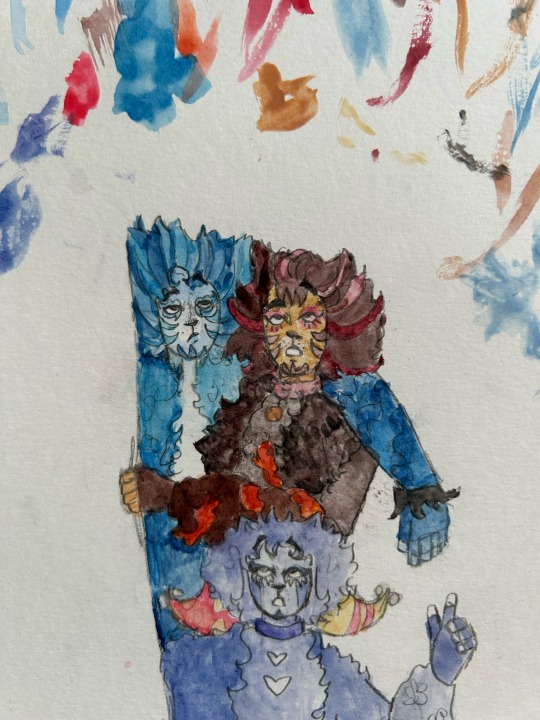
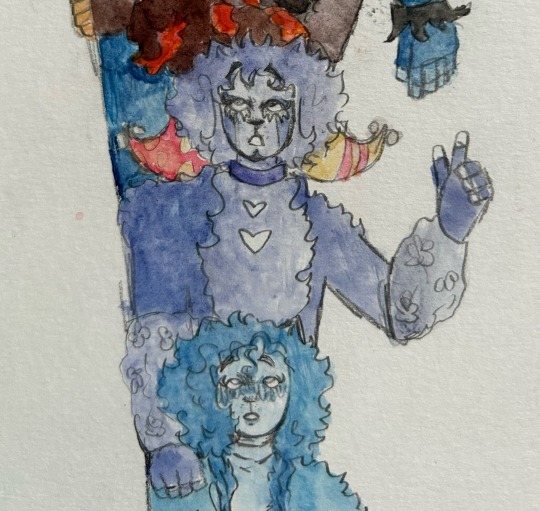

The gang’s all here!! They’re on the case!! And there’s no ghost that they wouldn’t chase!!!!!
@mysticalcats’s Foxglove, @toki-toro’s Chaumet, @emimii’s Clownaire, and my own Bluebelle :)
#this was indeed the project I was working on lmao#WHY DID THIS TAKE 17 BILLION YEARSSSSSS#I actually rly like how the actual paint turned out#ESPECIALLY FOR FOXGLOVE SQUEEEEE#he looks so cute….and I got all the colors mixed for Chaumet#watercolor oc painting: 1#back paint neck pain headache pain: 0#no but sketching this took such! a long! time!#I just straight up could not get foxglove and bluebelle right it was maddening#but I persisted and I beat the odds‼️‼️ Yipee‼️‼️#I love all of these guys so so so much I’ll prolly never stop thinking about them#please never stop talking about your ocs ever#and I am working on being coherent about Bluebelle as we speak!!!!#I got an idea and now I’m trying to make my brain not be mean about it#literally just chanting to myself ‘YOU! CAN MAKE! IT AS WEIRD!! AS! YOU WANT!!!’#shoutout to my fairytales throughout that ages book for inspiring me#100 points and a drawing of your choice if you can figure out the story Bluebelle’s backstory is based on lmao#ANYHOW#I just be rambling in these tags I perhaps need to calm down lol#I LOVE YALLS OCS FOREVER AND EVER!!!!#clownaire was literally perfect from the start I NAILED his pose first try and then he was very supportive the rest of the way through#live laugh love 🫶🫶🫶💐💐💐🩰🩰🩰#next up: Jemima painting!! with two special guests!!!#oh shit those are a lot of tags uhhhh I’m done now i promise 🫶🫶#cats the musical#cats musical#cats oc#jellicle oc#sorah’s silly scribbles#(also the text right under the drawing are a Scooby doo song LMAO it’s called Dig It Scooby Doo it’s insanely catchy)
34 notes
·
View notes
Text
I put a note in my email signature warning that I will be out of the office Monday in observance of the Jewish holiday of Yom Kippur. And after I added it, I started to worry that I was giving too much information and I could just say that I was going to be out of the office.
Of course anyone bothered by the fact I'm Jewish is not someone I want to do business with anyhow, so I decided it's fine.
Then I started thinking about the assumptions people might make of me - that I'm faithful or observant as a Jew - neither of which are true. I'm just a cultural Jew, but I do like taking the day to reflect and to fast and to not answer my phone or email.
And then I thought that a lot of Americans probably feel the same way about Christmas - they enjoy the day but maybe they're not faithful or observant Christians - but they don't have to ask for the day off or announce to anyone in their professional circle that they will be unavailable that day, and they don't have to worry about whether or not their co-workers will or won't know that they're actually atheist or have some other simply secular relationship to Christmas. They don't have to deal with any of the thought process I went through this morning on the way into work.
And anyhow that's a pretty good example that comes up all the time of cultural Christianity, and not to get too close to the discourse, but I think that's all we're really talking about here.
#anyhow not tagging this for what should be obvious reasons#this also seems pretty obvious to me#but i still see people fighting about it#and i get why it's sensitive#but also this is a pretty simple concept#so maybe you should kind of nod and accept the experience of people who are different from you#and that's all i have to say about that
55 notes
·
View notes
Text









Its calls didn't overlap with any other whales. It spoke in a mixed dialect, reminiscent of blue and fin whales, but it was talking to neither of them.
52 Blue: The loneliest whale in the world BY LESLIE JAMISON // spider-man 2099 (1992) #4 // Inside the Nail-Biting Quest to Find the 'Loneliest Whale' BY PAKINAM AMER // spider-man 2099 (1992) #10
#me when it coheres!!!!!!!!#gabriel o'hara#miguel o'hara#conchata o'hara#no tagging dana. who cares#this ain't about her#marvel comic blogging#anyway also please do not take this post to be disparaging towards gabriel. i hope the point that comes across is that among#three abuse survivors who have suffered in distinctly different ways all attempts at clear and open communication are failing#and in miguel's case he is sounding out at a frequency neither his brother or mother can hear or can hear and are not trying to understand#and that's due to resentment whether justified or not#for gabriel...#his behaviour is not perfect because he is coming from a place of extraordinary hurt and he also lacks the full story#anyhow. the tragedy here despite no one being dead. george left behind ruins
51 notes
·
View notes
Text
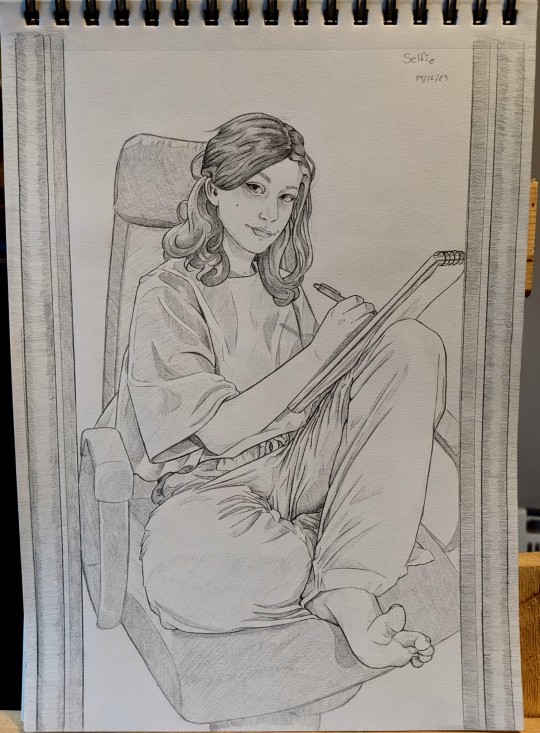
Self Portrait I drew in front of my mirror ฅ^•ﻌ•^ฅ
#art#drawing#doodle#artwork#illustration#sketch#self portrait#my art#sketchbook#sketchbook drawing#mirror drawing#pencil sketch#pencil illustration#self portrait drawing#portrait drawing#mechanical pencil#this would not be possible without my trusty 0.03mm mechanical pencil#ty graphgear#not sponsored I just enjoy the razor thin lines I get from my absurdly thin mech pencils#ew I probably sounded so gross and cheesy in this post#I swear I'm actually an emo bad bitch#Now that I posted this drawing I'm noticing all the little mistakes like the warping on my desk chair and how rushed the hair is lolololol#would you believe me if I told you that the most difficult part of this drawing aside from the arm was the sketchbook#I can easily falsify clothing folds and they don't have to be extremely accurate to still look believable#but godamn it was really hard for me to get the angle of the sketchbook and the loose paper in the back etc etc#This probably doesn't even look all that impressive to most and it may be cringe to be this happy with the result but what can you do#I doubt anyone will read these tags anyhow lolol this is just free vent space#oh and if you are reading these#thank you#also you just lost the game HAHA
21 notes
·
View notes
Text

He will never get it next time or anytime,
but in my arms he will be my favorite loser woooo~~
#sdv#stardew valley#sdv alex#stardew alex#sdv farmer#stardew farmer#stardew valley farmer#stardew valley alex#fanart#he can just be instantly emitted from all bachelor polls because we all know his result is (affectionate)#fshdh there's really nothing more unsurprising than sdv bachelor polls - other than how many people actually asking it#it's mostly always the same pattern of result#with seb and shane pitting each other#and he is at the very down bottom fshdh#a h ~ i see now tho elliott u are steadily slipping in between the two#anyhow good night!#lmao everytime people drawing bachelors in a set i just hope they don't hate alex enough to not draw him because i still want to seee~~~#he will only be drawn when people decided to be generous with him#but usually he will be the last if he did get drawn so it took a long wait to see him#RIP me#*closes eyes#there are still 2 artists i wish to see him from#i wonder if the set will ever continue to actually reach him#i was on bed already#but i jumped out of it again to console him
647 notes
·
View notes
Text
youtube
Watch the 2024 American Climate Leadership Awards for High School Students now: https://youtu.be/5C-bb9PoRLc
The recording is now available on ecoAmerica's YouTube channel for viewers to be inspired by student climate leaders! Join Aishah-Nyeta Brown & Jerome Foster II and be inspired by student climate leaders as we recognize the High School Student finalists. Watch now to find out which student received the $25,000 grand prize and top recognition!
#ACLA24#ACLA24HighSchoolStudents#youtube#youtube video#climate leaders#climate solutions#climate action#climate and environment#climate#climate change#climate and health#climate blog#climate justice#climate news#weather and climate#environmental news#environment#environmental awareness#environment and health#environmental#environmental issues#environmental education#environmental justice#environmental protection#environmental health#high school students#high school#youth#youth of america#school
21K notes
·
View notes
Text

Clown to Equine communication failed; They are separate species.
[First] Prev <--> Next
#poorly drawn mdzs#mdzs#season 1#bonus comic#wei wuxian#little apple#lan jingyi#lan sizhui#This bonus comic is for all my fellow little apple lovers#she doesn't show up for quite a while after this so I need to wring out every bit of screen time for her#That's what feminism is about. Equine visibility.#Women need to remain mysterious + unknowable + untethered by rules#Women need to canter across the plains and sleep standing up#Women need to be hand fed apple slices 4 times a day#joking aside I do love the co-chaos of lil apple and wwx#though the new duo dynamic that follows (with LWJ and WWX getting way more time together) its *obviously* iconic#god...to be two cultivation partners following directions from a severed arm...#anyhow. I think this might be one of the jokes that is only funny to me#my realism studies are still in that uncanny/awkward phase but I love the 'detailed version of a very stylized character' visual gag a lot#Taps my blog name again. Don't forget the name on the tin#oh wait lwj should be in this scene too...let's retcon it and say he's bending down to pet his bunnies goodbye
2K notes
·
View notes
Photo


Hey, hey! RnR not requested! (Patreon)
#Doodles#SCII#DAX#ZEX#Does anyone still use RnR lol#I think I was a little too late for that but in my brief stint on FF.net I did get a couple reviews so *shruggles*#ANYway lol#The topic of VUX poetry came up and it would not leave me alone#But at the same time it is so hard to English-phoneticize VUK ZIX into my preferred poetry method!#So I gave up and went with a playground chant lol#I also wasn't sure which direction it would be read in apart from bottom-up :0#Japanese is top-down right-to-left so maybe it's inverse?? I don't know!#That's what I went with this time anyhow lol#Also making up rules on the spot lol - ''a'' is always contextually inferred by its surroundings#Have I thought about the implications of inferred subject/singular vs. plural phrasing? No! Give me some time tho ♪#Lol#I have also pretty firmly come to the conclusion that -ing sounds just aren't a thing lol#At least not written and not comfortably spoken#You could force the sound but it's exactly what it says on the tin - forced#So the rhyme-scheme is a bit funny haha - that rhyme doesn't translate at all! But it is still fun to write a little ship-poem hehe#ZEX does not approve but it's not his poem is it! Tentacles to yourself! Don't stick your trunk where it's not wanted!#I do love when DAX is silly and lovestruck haha
102 notes
·
View notes
Text


“Then you'll just have to take me at my word. I'm not the same person I was.” — Kompromat by @lightyaoigami
#real tags first u know the drill#death note#deathnote#lawlight#light yagami#l lawliet#my art#okay real tags done#consistent art style.. idk her#but oooo look at the pretty colors oooh#they are distracting you from my wildly heavy line work shhhhhhh#and its raining!! atmosphere!! and its all red lighting and stuff oooo#anyhow#this is a lil pick me up for monica#ALSO go read the fic#this is one of two things im doing for this fic#so go read it and by the time you’re done i’ll probably have the new art out lol#thats a lie the second thing i plan to do is going to be pretty involved#stay tuned#also L smoking is such a thing for me right now… what brand do we think he smokes?#I’m an american so to me Luckies are the hot sexy person’s poison…#but lets be real he couldn’t handle them.. too bitter#if im being real he smokes menthols which….. :/
133 notes
·
View notes
Text
So like, mini disclaimer before the post. I was not and am not a believer in the "Sonic is going to be forced to choose between his original friends and the shatterspace variants" theory, nor the companion to it "all the variants are just gonna essentially live with their memories inside the og friends' hearts"
However, I do have brainrot over the idea of Nine meeting Tails in his dreams, and some of these ideas require a prerequisite of "in which Nine exists within Tails' heart but does not currently have a body.
ㅤ
Imagine, if you will, a setting post canon in which the variants exist within the hearts of the original and (kingdom hearts style) they would just need a body/vessel of their own to exist again. Tails is sleeping, and after dreams upon dreams of meeting the variants, experiencing their fleeting memories and their hurt (their feelings about everything), he comes across Nine.
Nine... Tails has had a hard time remembering much of his dreams while awake, but when he's dreaming, he remembers that Nine has been perhaps the angriest and most conflicted of all the variants. All of them want to be alive, of course. Tails wouldn't be surprised if *all* of them have been parsing through his own memories in exchange for sharing theirs.
But none have been so volatile as Nine, harder to reason with. The others at least face him more often than not, but Nine has directly done so few times.
But...Tails can't blame him for that, especially not after what he knows. He understands how Nine likely feels (abandoned, lonely, forgotten). Perhaps he wouldn't be so agreeable either if he fought tooth and nail for a better future, and the universe denied him that (nay, punished him to watch but to never have).
But tonight...
Nine is standing under a palm tree, facing the vast ocean past the beaches of Green Hill. Tails takes a few steps down the hill he's on, and soon enough he's standing off to the side (dream logic, he understands)—where he can see Nine from the front, but isn't standing directly in front of him or obstructing his view.
It's at this moment that Tails realizes he's never seen Nine so clearly before. The tips of his ears, to his permafrown, to his 7 mechanical tails, and down to his shoes. He's fought the fox before in his dreams, seen glimpses of him, but this is the first time he's had a chance to really see him.
Nine turns his head away from the sea, and suddenly Tails is beside him, mere feet away.
Tails opens his mouth, a dozen questions and sentence starters flying through his head. What eventually comes out is just a simple, "Nine?"
Nine smiles at that, and yet...Tails can tell almost instantly that it's not because he's happy or excited to see him. No, the smile is almost...accepting, if not a little bit sad.
Then, Nine sighs. "This could have been the other way around, but...it has to be you."
Tails hesitates for a moment before pointing at himself. "...Me? Why?"
"There are so many people connected to you—all of you, if my hypothesis is correct. It often is. You're me, so...you can feel what I felt. You could...feel how I feel."
And maybe it's true that Tails can feel what Mangey, Sails, and Nine are feeling, but all that proves is that one is affected by the presence of others residing within their own consciousness.
Tails shakes his head. "No. You're you, not me."
There's a moment of silence before Nine chuckles, and Tails continues, "I want you to know that you deserve to live as your own person, just as much as I do."
"Every time we've fought—here—I've asked you the same question. Do you remember it?"
Well, of course, Tails finds multiple questions as he tries to think back, but by keeping the terms of Nine's question in mind and employing process of elimination–
Nine turns back to the sea, squeezing both gloved hands into fists at his sides. "I was angry—among other things. I just couldn't understand why I was here. After everything I'd fought for, everything we'd been through together, I couldn't understand why he chose you. And every time I asked, you never gave me an answer."
Nine's right. Tails has never given him an answer to that question.
But to Tails...that question was never his to answer, at least in his opinion. Unless Sonic told him, Tails would never know why he put in for him, Amy, Knuckles, and Rouge over worlds of new friends. All he does know (straight from Sonic's own testimony) is that Sonic would have never made the choice he did had he known it would lead to all this. Sonic had wanted home, Tails, and all his friends back, but he never meant to erase the other worlds. Even as he tries to pretend otherwise, Tails knows Sonic has been beating himself up for the choice he made ever since.
Shouldn't Nine know that—that Sonic didn't mean to hurt him, that Sonic feels regret, that Sonic wasn't intending to choose between one or the other?
"Nine–"
"Save it," Nine says, cutting him off. "It doesn't matter anymore. Sonic made his choice, but you still have that chance."
Nine turns back to Tails and holds out a hand.
Tails looks down, then back up at Nine. He hesitates for a second, but ultimately takes Nine's hand.
Tails is an observer, a spectator without form, as memories begin to play out before him in quick succession. Despite the lack of form, somehow his head begins to ache in pain that only grows over the moments.
And then, he begins to notice a pattern in the memories shown to him. Despite the pain, he recognizes the clear shift since a certain blue hedgehog—Sonic, of course—saves Nine from being hit by a train.
Each and every memory, if Sonic wasn't centered or mentioned in it, then his palpable absense was the focal point. Nine fought him, he worked with him, he almost lost him, he thought he lost him, and then he fought him again.
Nine had spent most of his life lonely, though he hadn't realized that until his life was almost over.
A waterfall of emotions hit him then, just before the highlight reel crackles into black.
And then, Tails is standing beside Nine again, head pulsing and heart pounding. He can hardly remember what he's just seen, and that waterfall of emotions seeps through his fingers as he tries to catch them, to study them.
All he knows is that he understands. Somehow, he understands why Nine feels the way he does. Now, more than before, he understands why Nine is hung up on Sonic the way he is.
Perhaps, Tails thinks, he understands how it feels for Nine to be with Sonic (and without him) far more than anyone else.
Tails musters up a look of determination as he stares into Nine's eyes, and he squeezes his hand. "I'll figure it out. No matter how long it takes, I'll make sure you—you, and Sails, and Mangey, and the rest—can walk along the beach. You don't deserve to sit here and watch like this. None of you deserved to have your lives taken."
And Nine... Nine smiles, like he just can't help it. "Don't you see? That's why it has to be you."
There's a feeling, an almost indescribable feeling, that strikes Tails' heart at that.
"I promise," Tails says.
And then, he’s sitting up in his bed, breathing deeply.
As he makes himself get up, get ready, and rush into his lab, there's little he remembers from his dream as always.
But he knows what he has to do.
I'll make sure of it, Nine.
#sonic prime#nineails#tainine#tailsnine#Ship names hard guys!#tailscest#I'll probably just use that as an overarching ship name#i just be ramblin#I have one more of these meetings in my brain‚ but this one went on so long I think I'll have to make a separate post#Anyhow in the world my little musings‚ I do believe Tails will work hard to figure out how give all the variants proper vessels#but as this *is* also meant to be a tainine/nineails post (with some implied sontails and sonine) he's going to be fixating on helping#Nine first#my writing#I guess?#it kind of turned into a whole thing#Personally where the feelings come in between them for me is both from the fixation (the 'why does it have to be you' condflict vs the#'I want to soothe your pain and fix this')‚ and bonding over the feelings and experiences they share (especially regarding Sonic)#Although let's be real here. I just love selfcest and two characters bonding over their love for the same person kinda ships#Also final mention‚ yeah. If you didn't guess‚ this interaction is based upon the Sora and Roxas interaction in KH DDD#sonic the hedgehog#nine sonic prime#miles nine prower#nine the fox#miles tails prower#tails the fox#semi long post
20 notes
·
View notes
Text
youtube
Watch the American Climate Leadership Awards 2024 now: https://youtu.be/bWiW4Rp8vF0?feature=shared
The American Climate Leadership Awards 2024 broadcast recording is now available on ecoAmerica's YouTube channel for viewers to be inspired by active climate leaders. Watch to find out which finalist received the $50,000 grand prize! Hosted by Vanessa Hauc and featuring Bill McKibben and Katharine Hayhoe!
#ACLA24#ACLA24Leaders#youtube#youtube video#climate leaders#climate solutions#climate action#climate and environment#climate#climate change#climate and health#climate blog#climate justice#climate news#weather and climate#environmental news#environment#environmental awareness#environment and health#environmental#environmental issues#environmental justice#environment protection#environmental health#Youtube
20K notes
·
View notes